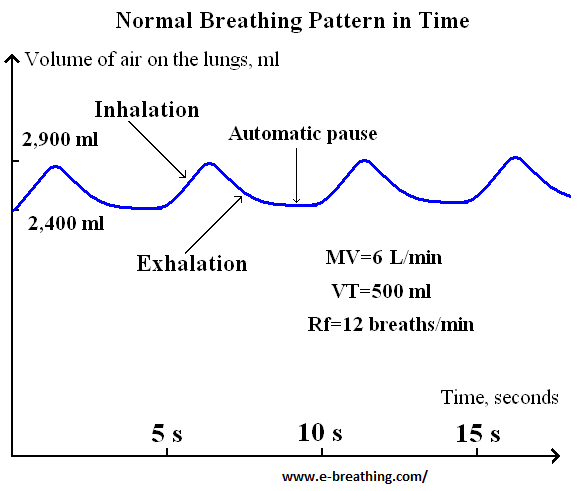Normal Respiratory Rate, Volume, and Chart
When it comes to respiratory minute ventilation at rest, the physiological and medical norm is 6 liters per minute for a 70 kg man. The following numbers for normal breathing are also mentioned in several textbooks:
1. Normal TV (tidal volume or air volume that is breathed in during a single breath) – 500 ml 2. Normal Rf (respiratory frequency or respiratory rate) – 12 breaths per minute 3. Inspiration – about 1.5-2 seconds 4. Normal exhalation is 1.5-2 seconds, followed by an automatic pause (no breathing for about 1-2 seconds).
Respiratory Rate Chart (Graph)
Through this graph, you can easily acquire information about the normal breathing pattern at rest, or the dynamics of the lungs’ volume as a function of time. Herein, it is evident that it corresponds to the normal breathing rate of 12 breaths/minute.
NOTE: It is simply not possible for us to measure our own breathing frequency or respiratory rate. This is because our breathing immediately changes as soon as we start paying a bit of attention to it – instantly, we start breathing slower and deeper. This way, you can expect your result to be 2-3 times smaller as compared to your real numbers all through your basal breathing pattern at rest. For instance, you will count 7 breaths/min, whereas your actual breathing rate will be about 18-20 breaths/min. Hence, you may breathe faster than the normal respiratory rate, but your test would show that you breathe substantially slower than the normal respiratory rate (12 breaths/min) – this is one of the most common mistakes ever!
Other parameters of normal breathing
If an individuals holds his/her breath after a normal exhalation, it takes around 40 s before breathing finally commences. For this reason, the normal breath-holding numbers (immediately after usual exhalation and after an exhale) is somewhere around 40 s. This is indicative of normal oxygenation of tissues and cells.
The existing medical norm for CO2 pressure in the alveoli of the lungs or arterial blood is nearly 40 mm Hg. This number was established nearly a century back by the famous British physiologists by the names of Charles G. Douglas and John S. Haldane (Oxford University).
Now, what else is known about other parameters of normal breathing? For starters, it is invisible (doesn’t trigger chest or belly movements), regular, and inaudible (meaning that it doesn’t trigger panting, wheezing, yawning, sighing, coughing, sneezing, or deep inhalations/exhalations).
Pediatric Respiratory Rate Chart
(Newborn, Toddlers, Infants, and Children)
| Groups and ages | Normal respiratory rates |
| Newborns to 6 months old | 30-60 breaths/min |
| 6 to 12 months old | 24-30 breaths/min |
| 1 to 5 years old | 20-30 breaths/min |
| 6 to 12 years old | 12-20 breaths/min |
Important note. Clinical evidence suggests that respiratory rates
in healthy children are near the lower limits or even below it.
Breathing frequency during exercise (physical activity) can be up to 30-60 breaths/min depending on its intensity.
How can I measure my own breathing?
If you wish to define your own breathing pattern, you need to measure your body oxygenation or breath-holding time right after your usual exhalation. However, do so only until the time that you experience initial discomfort or stress. Once this CP test is completed, it will be possible for you to define your health state with the help of the Buteyko Table of Health Zones.
A person who has normal breathing will have nearly 40 s for the body oxygen test. In case of chronic overbreathing, breath holding time becomes substantially short.
Individuals who are sick have deep and fast breathing 24/7 and reduced body oxygenation (nearly 10-20 s of oxygen in tissues). In terms of patients who are severely sick and critically ill, body oxygenation tends to be below 10 s.
Dr. Buteyko, on the basis of his studies of countless sick and healthy individuals suggested varying norms in terms of breathing. What exactly are his norms? For instance, his nNormal respiratory rate is a mere 8 breaths/min. In case of normal breathing, here are his numbers:
1. Normal minute ventilation – 4 l/min 2. Normal tidal volume (air volume breathed in during a single breath) – 500 ml 3. Normal breathing rate or frequency – 8 breaths per minute 4. Inspiration – about 1.5 seconds 5. Exhalation – 2 seconds 6. Automatic pause (or period of no breathing after exhalation) – 4 seconds 7. Breath holding time (after usual exhalation and without any stress at the end of the test) – 60 seconds 8. CO2 concentrations in the alveoli or arterial blood – 6.5% or about 46 mm Hg (at sea level)
Both of these norms (official and Buteyko’s) along with other related values can be found in the Buteyko Table of Health Zones.
[end_tabset]


